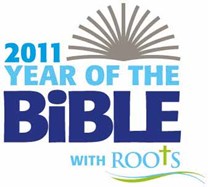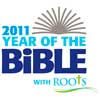Year of the Bible resource material for young people to help us discover more about God
 God who makes the first move
God who makes the first move
In the next of our series of resources to support your celebration of the Year of the Bible, Dr Steve Mallon from the Discipleship and Mission team of the Church of Scotland, provides discussion material, questions and activities to help your youth group discover the God who takes the initiative.
With younger groups
If you have a younger group, you might like to access the material based on the Genesis description of creation. This special Harvest material, ‘In the beginning, when God created…’ considers the whole of creation to help us understand and celebrate God’s power and provision. We celebrate its variety and abundance, and take time to appreciate and enjoy it, but we also face the challenge that God created us to tend and care for creation, a great theme to consider at Harvest, wherever we live. The activities, presented in the Harvest material, are in three sections: Create, Celebrate and Care.
Introduction for leaders
The Bible is the most fantastic book about God. It is a bit like the old This is Your Life red book (for those old enough to remember that programme): a compendium of stories and memories, anecdotes and pictures that, when pulled together, reveal a rich tapestry-style picture of God. There are so many qualities and characteristics of God that we could explore, but here we focus on the God who often makes the first move, takes the first step in bringing things into being, or creates the opportunity for someone to see things in a new way. We can see in almost every book of the Scriptures that, when God acts in this way, his people are invited to respond and to move towards him in how they live, and the relationships they build. God’s followers today are encouraged to do the same.
Something out of nothing
Today we focus on two passages from Scripture that show God making the first move: Genesis 1, the creation story and John 4, the encounter Jesus has with the woman at the well.
You might want to use both sections of the study in one session, or to separate them over two sessions. Each passage offers a lot of opportunities, so don’t be afraid to take your time!
In both passages, God makes something out of nothing and everything changes as a result. The passages are a good contrast, because one deals with a huge idea – the story of creation itself and God’s relationship with it – and the other explores God’s interaction, through Jesus, with individual human beings. The God of the Bible cares about both. As Christians, we live with a God who is big enough to fill space and small enough to fit into our lives, and in either dimension is able to act on impulse, to make the first move and to bring about change.
Open the Word
Based on Genesis 1
You will need: copies of Genesis 1 for each young person present.
- Young people may already know this story and have differing opinions about it. Some may believe it to be a factual account of events that actually happened, while others might think of it as myth, a story that explains a truth. That’s not the discussion for this study. Instead, we want to focus on what the creation story tells us about the character of God.
- Have the room as dark as possible and read the passage in a dramatic way. This is an amazing story that explains the beginning of everything and the intentions behind it. After you have read the story to the young people, allow them to sit in the darkness for a few moments, then read out the list below to them.
the universe, light, the sky, earth, plants, sun, moon and stars,
fish and birds, animals, men and women.
- Discuss with the young people:
Consider ways in which God created everything.
Do you see an order? Does it make sense?
If you changed the order what impact do you think this might have on the whole story?
What clues does the passage give us that show what is behind God’s initiative? What hope does that offer to us and to the world we live in today?
John 4
Begin by reading the story of the woman at the well.
- Your young people may have little idea of just how powerful the encounter is between Jesus and the woman described here. A good way to consider this passage is to look at the outcome and then work back to the start of the story.
- Set the scene by saying that the woman in the story is the most despised woman in town. She is the lowest of the low, and is ignored by everyone in her society.
- Discuss with the young people,
Are there people today who occupy a similar role in their communities?
On what grounds do people get ignored and despised:
1 within your group?
2 in the local area?
3 in the world in general?
How might we be more forgiving and accepting?
- Towards the end of our story, the woman runs and asks everyone to follow her to meet someone. They all leave the town and follow her. This is a surprise, given her status in the town and what everyone knew about her. So what happened?
- Now read the passage from verse 5 to verse 30 and give the young people time to think about the story. Once they have had time to reflect, you might say the following phrases, allowing them a moment to ponder each one before moving on to the next:
* Here Jesus takes the initiative and makes the first move.
* He talks to a woman – not something that was really done in his day.
* She is a Samaritan woman – yet the Jews and Samaritans didn’t get on.
* She is a despised woman with a bit of a past. He doesn’t seem to care about any of this, and his first words to her are a simple request, ‘give me a drink of water’.
* As a result of that and the ensuing conversation, the woman forgets the reason for her being at the well in the first place, and rushes back to share the story with everyone in her town. She forgets who she is, and what she has done, and she runs back to town.
* Everyone stops what they are doing and follow her back to see Jesus, it would appear that she is so different that they forget who she is too! What changed?
- This passage shows Jesus making the first move towards someone who would otherwise have been forgotten, and as a result, the woman and her entire community are offered the possibility of change.
Ask the young people to discuss the following:
What does the story tell us about what changed?
What does this say to us?
What does this story teach us in terms of the people we were thinking about earlier?
How might this reading have an impact on our world?
Respond to the Word
Making the first move in your church
Think about actions to take together.
You will need: a flip chart and marker pens.
- Invite your group to think about five different things you could do to make your church a better place. You might want to think about this in terms of welcome, caring for one another, and so on.
- You might work in small groups, all together, or allow people a moment to think on their own.
- Once you have shared lots of ideas, vote as a group for the top three and then figure out a way to make these three things happen.
Making the first move in your community
Identify community needs.
- Invite the young people to think about the greatest needs faced by people in your local community. For example, are there lots of lonely old people? Are there young people who need friends and a bit of support? Are there parts of your area where rubbish needs to be picked up?
- Work out if there’s something you could all do that would make a positive difference.
By the well
A storyboard activity
You will need: a copy of the storyboard template.
- Beforehand, print and cut out the storyboard scenes and put them in the wrong order.
- Ask the group to put them into the correct order, and add colour to show the woman’s change from sadness to joy, as she got to know Jesus.
Act it out
A dramatic retelling
- Invite the young people to turn the story in John 4 into a news item for a local TV station.
- They might need to consider:
What would the headline be, something that would grab the attention of the viewers at home?
Who would you want to interview – assuming Jesus is not available?
How would you get the essence of the story across to people who haven’t been directly involved in it?
Creator God
Prayer activity
- The two readings reveal something of the God who calls us to life. God brings life to the whole of creation in the Genesis reading, and to all the people in the village, in the passage from John. Invite people to consider how God brings them life and inspires them.
- The group might share ideas about ways God brings life to the world around us. Then pray together:
Wonderful, inspiring, creating God,
we thank you for the beauty of your world.
Help us to see you in the people around us,
those we don’t understand;
those who are not like us;
those who challenge us when we’d rather stay
in the comfort of our own friendship groups.
Help us to respond to your call so that we become wonderful, inspiring, creative too.
Help us to reach out to those we don’t understand;
those who are not like us;
those who challenge us when we’d rather stay
in the comfort of our own friendship groups.
Amen.
Images: Woman at the well, Jesus with woman at the well
You are welcome to reproduce this article within your church or organisation.
Please ensure that the copyright line 'This resource is taken from www.rootsontheweb.com and is copyright © ROOTS for Churches Ltd 2011.' is included.
You can find out more about the Year of the Bible on the website www.2011trust.org .
 Go to index of all ROOTS
Go to index of all ROOTS
Year of the Bible 2011 material